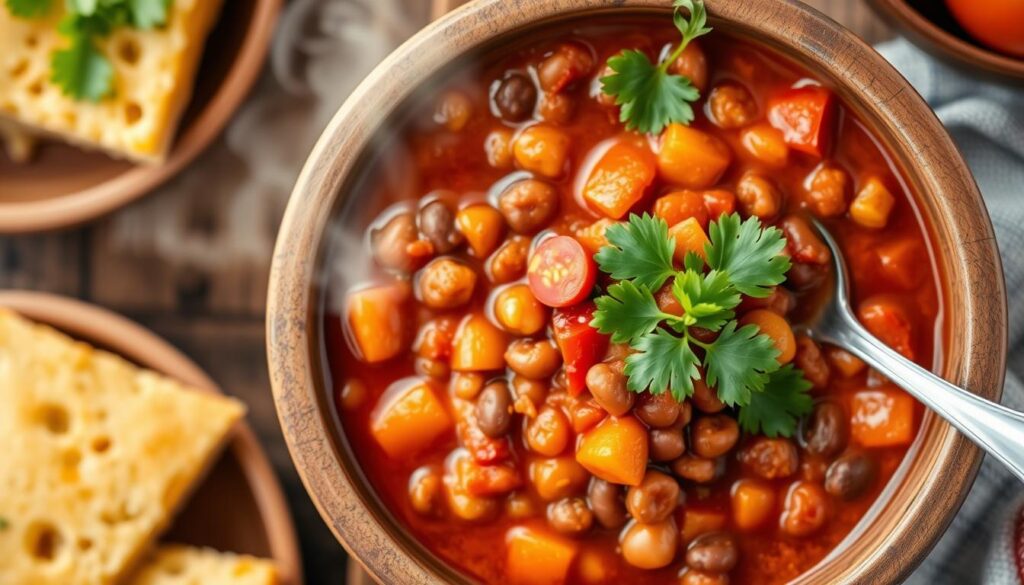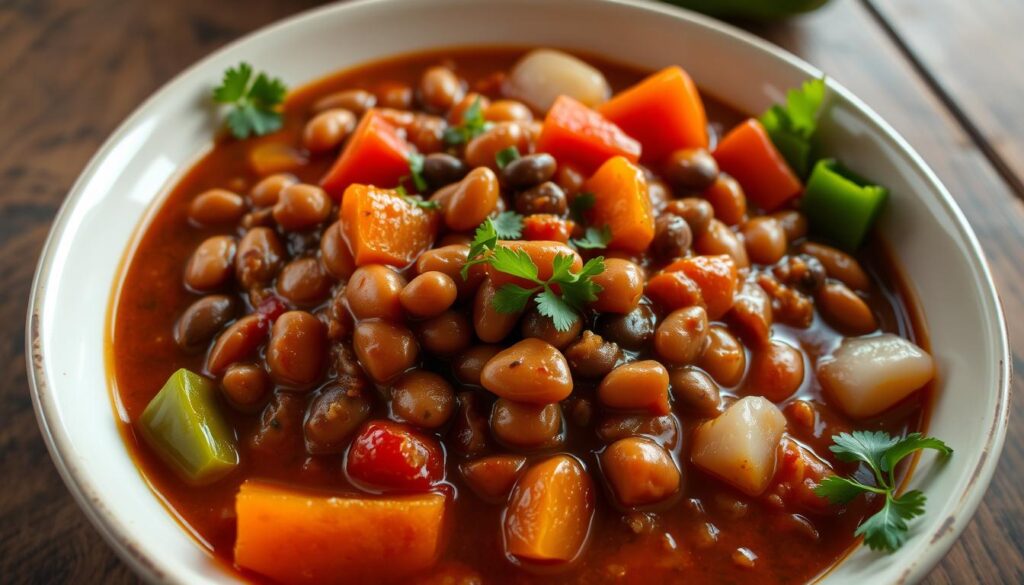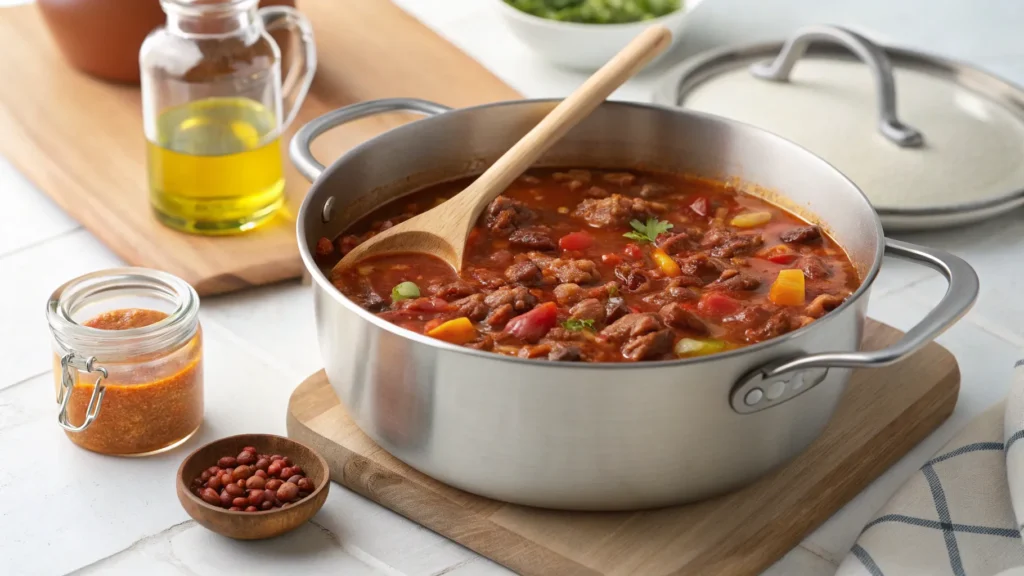Ever wondered what happens if you skip draining kidney beans for chili? Kidney beans are a key part of chili, and how you prepare them makes a big difference. Not draining them can change how your chili tastes and feels.
Table of Contents
Introduction to Kidney Bean Preparation
Preparing kidney beans for chili is more than just tossing them in. Knowing the effects of not draining them can make your chili better. By focusing on the right preparation, you can elevate your chili game.For an insider’s look at improving your chili, check out The Secret to Really Good Chili.
Key Takeaways
- Proper kidney bean preparation for chili is essential for flavor and texture
- Not draining kidney beans for chili can affect the overall quality of the dish
- Kidney beans in chili require careful consideration to achieve the best results
- Understanding what happens if you don’t drain kidney beans for chili can improve your recipe
- Kidney bean preparation for chili involves more than just adding the beans to the pot
- Draining kidney beans for chili is a key step in cooking
Understanding the Importance of Bean Preparation in Chili Making
Preparing beans is key to making a tasty and true chili dish. You might wonder, should you rinse kidney beans for chili? And what’s the deal with kidney beans in canned chili? The answer is in the bean prep’s role in chili making.
In traditional chili, kidney beans are a must. They add protein, fiber, and flavor. To get the most from your beans, proper prep is a must. This means rinsing and draining to remove sodium and impurities.
The Role of Kidney Beans in Traditional Chili
Kidney beans are a top pick for chili. They have a mild taste and a firm texture. This makes them perfect for hearty chili dishes.
Why Bean Preparation Matters
Good bean prep is essential for the best chili taste and texture. Rinsing and draining kidney beans gets rid of extra sodium and impurities. This leads to a more balanced flavor.Wondering whether to use dried or canned beans? Learn about the pros and cons of both in this guide to Using Dry Beans for Chili.
Different Types of Kidney Beans for Chili
There are many kidney bean types for chili, like light red, dark red, and white. Each has its own taste and texture. So, pick the one that fits your chili recipe best.

Knowing how to prep beans and picking the right kidney beans is vital. It helps make a delicious and authentic chili. Whether using canned or cooking from scratch, proper prep unlocks the beans’ full flavor and texture.
What Happens If You Don’t Drain Kidney Beans for Chili?
When making chili, kidney beans are key. But, not draining them can change your dish’s texture and taste. If you skip draining kidney beans for chili, your chili might become too watery. This can be a turn-off for some.
Let’s explore how not draining kidney beans impacts chili. Here are some important points:
- The extra liquid can weaken your chili’s flavors, making them less rich.
- The chili’s texture might become too thin, which not everyone likes.
- Not draining kidney beans can also mess with your dish’s consistency. It makes it hard to get the right thickness.
It’s key to think about these points when deciding to drain kidney beans for chili. Knowing the effects of not draining can help you make better choices. This way, you can make a more enjoyable chili.

In short, skipping the drain on kidney beans for chili can really change your dish. Being aware of these changes lets you prepare your kidney beans right. This way, you can make a tasty, top-notch chili.
| Factor | Effect of Not Draining Kidney Beans |
|---|---|
| Texture | Too watery, thin consistency |
| Flavor | Diluted flavors, less intense |
| Consistency | Difficult to achieve desired thickness |
The Science Behind Bean Liquid Composition
When soaking kidney beans for chili, it’s key to know about bean liquid. This liquid has proteins, carbs, and fiber. It changes your chili’s taste and texture, which is crucial when understanding what happens if you don’t drain kidney beans for chili.
The liquid is full of nutrients like potassium, magnesium, and iron, which boost your chili’s health value. However, canned bean liquid can also have salt, sugar, or preservatives. These additives can affect both the taste and health aspects of your dish, emphasizing the importance of knowing what happens if you don’t drain kidney beans for chili.
Nutritional Content of Bean Liquid
- Potassium: essential for heart health and blood pressure regulation
- Magnesium: critical for muscle and nerve function
- Fiber: aids in healthy digestion and bowel function
Chemical Components in Canned Bean Liquid
It’s important to know what’s in canned beans. Some have a lot of sodium or sugar. To reduce these effects, rinse the beans or choose low-sodium options.
How Bean Liquid Affects Cooking Process
The bean liquid can make your chili thicker or thinner. When kidney beans in slow cooker chili cook, the liquid makes a tasty broth. Knowing about bean liquid helps you get the right chili consistency and flavor.
| Bean Type | Nutritional Content | Chemical Components |
|---|---|---|
| Kidney Beans | Potassium, Magnesium, Fiber | Sodium, Added Sugars |
| Black Beans | Fiber, Protein, Folate | Sodium, Preservatives |
Impact on Chili Texture and Consistency
When cooking chili, bean preparation is key. It greatly affects the dish’s texture and consistency. A vital cooking tip is to drain and rinse beans before adding them. If you’re wondering what happens if you don’t drain kidney beans for chili, skipping this step can result in excess sodium and impurities, which may negatively impact the flavor and texture of your dish.
Draining beans is critical in bean preparation. It prevents the chili from becoming too watery or mushy. By draining beans and rinsing them in cold water, you remove excess starch and impurities. This makes the chili more flavorful and textured. Here are some tips to keep in mind:
- Always drain and rinse canned beans before adding them to the chili.
- Use a colander or fine-mesh strainer to drain the beans and remove excess liquid.
- Rinse the beans with cold water to remove excess starch and impurities.
By following these cooking tips and properly preparing your beans, you can create a delicious and satisfying chili. Always drain beans and rinse them with cold water for the best results.
Flavor Implications of Undrained Kidney Beans
Using kidney beans in your chili can be a great choice. But, not draining them can change the flavor. The liquid from canned beans adds depth but can make the dish bitter or salty if not balanced.
To get the perfect taste, you need to know how to use kidney beans. Understanding how bean liquid affects taste is key. Start by tasting the bean liquid and decide if you should use it or not.
How Bean Liquid Affects Taste
The bean liquid can make your chili richer but can also make it bitter or salty. To fix this, add ingredients like onions, garlic, or tomatoes. They help balance the flavors.
Balancing Flavors in Your Chili
To balance your chili’s flavors, try adding:
- Onions
- Garlic
- Tomatoes
- Spices
These ingredients can counteract the bitterness or saltiness. They help create a balanced taste.
Professional Chef Recommendations
Professional chefs suggest using different cooking techniques for the best flavor. Try sautéing onions and garlic before adding beans. Or, mix spices to add depth. By following these tips, you can make a delicious, balanced chili.
3 Surprising Facts About Not Draining Kidney Beans for Chili
When it comes to making chili, skipping the step of draining kidney beans can have unexpected consequences. Here are three surprising facts about how this choice impacts your dish:
- Watery Texture: The extra liquid from canned beans can make your chili too thin, disrupting the hearty, thick consistency chili lovers expect.
- Diluted Flavor: Instead of enhancing the flavor, the bean liquid can dilute the spices and richness, leaving your chili tasting bland.
- Excess Sodium: Canned bean liquid is often high in sodium, which can lead to an overly salty dish if not balanced properly.
Understanding these surprising facts can help you make informed decisions when preparing kidney beans for chili, ensuring a flavorful and perfectly textured dish.
Health Considerations and Safety Aspects
When cooking kidney beans for chili, it’s important to think about health and safety. Kidney beans are full of protein, fiber, and nutrients. They’re great for a healthy diet.
But, it’s key to cook them right to avoid health risks. Raw or undercooked kidney beans can cause food poisoning. This is because of a toxin called phytohemagglutinin (PHA). So, make sure to soak and cook them well before adding to your chili.
Here are some important safety tips for cooking with kidney beans:
- Soak the kidney beans in water for at least 8 hours before cooking
- Cook the kidney beans at a high temperature (at least 180°F) for a sufficient amount of time (at least 30 minutes)
- Avoid eating undercooked or raw kidney beans
By following these tips, you can make a tasty and safe chili with kidney beans.
Always put food safety first. Handle kidney beans and chili carefully to stay healthy.
| Health Benefits | Health Risks |
|---|---|
| Rich source of protein, fiber, and essential nutrients | Food poisoning due to undercooked or raw kidney beans |
| Can help lower cholesterol levels and regulate blood sugar | Allergic reactions to kidney beans or other ingredients in chili |
Best Practices for Draining and Rinsing Kidney Beans
Cooking with kidney beans requires the right draining and rinsing methods. These steps are key to getting the best taste and texture in your meals. If you’ve ever wondered what happens if you don’t drain kidney beans for chili, understanding proper preparation techniques can help you avoid issues with flavor and texture. We’ll cover the best ways to drain and rinse kidney beans, including the tools you need.
Proper Draining Techniques
To drain kidney beans, pour them into a colander or fine-mesh strainer. Then, rinse them with cold water to get rid of extra liquid. This step is important because it cuts down on sodium and makes the beans taste better.
Tools and Equipment
Having the right tools is important for draining and rinsing kidney beans. You’ll need a colander or strainer to get rid of excess liquid. Also, a bowl or container is necessary for rinsing the beans. Using the right tools and techniques ensures your beans are well-drained and rinsed, leading to better-tasting dishes.
Alternative Methods for Using Bean Liquid

When cooking with kidney beans in chili, you might wonder about not draining them. Draining is common, but there are other ways to use the bean liquid. This liquid can make your chili taste better and feel creamier.
Using the bean liquid can add protein and fiber to your chili. It also helps reduce waste. But, it might make your chili saltier. To fix this, season your chili carefully with herbs and spices. This way, you can add flavor without extra salt.
- Use it as a substitute for some of the water or broth in your recipe
- Add it to your chili towards the end of cooking time to avoid overcooking the beans
- Use it as a base for a vegetarian or vegan chili, adding more plant-based ingredients for flavor and texture
Exploring these alternatives can make your chili unique and tasty. Whether you drain or use the bean liquid, the goal is to find what works best for you and your recipe.
Tips for Achieving Perfect Chili Consistency
Getting the perfect chili consistency can be tricky. It’s all about how you prepare your beans, like kidney beans. If you’re curious what happens if you don’t drain kidney beans for chili, the extra liquid from the beans can make your chili too watery and affect its thickness. With a few simple tricks, you can make a chili that’s both delicious and satisfying.
Controlling the thickness of your chili is key. You can do this by reducing liquid, adding thickening agents, or simmering it longer. It’s also important to adjust the liquid ratios to balance flavors and textures. For instance, adding more broth or water can thin it out, while less liquid makes it thicker. Proper preparation of your beans, including draining and rinsing, ensures the ideal consistency.
Thickness Control Methods
- Reducing liquid: Simmer the chili for a longer period to reduce the liquid and thicken the consistency.
- Adding thickening agents: Use cornstarch, flour, or other thickening agents to achieve the desired consistency.
- Simmering: Let the chili simmer for a longer period to allow the flavors to meld together and the consistency to thicken.
Adjusting Liquid Ratios
To adjust the liquid ratios, you can add more broth or water to thin out the chili, or reduce the amount of liquid to create a thicker consistency. This will also depend on the type of kidney beans for recipes you are using, as some may absorb more liquid than others.
Troubleshooting Common Issues
By following these tips and focusing on bean preparation, you can fix common cooking problems. If your chili is too thick, add a bit more liquid. If it’s too thin, simmer it longer or add a thickening agent. With practice, you’ll get the perfect chili consistency every time.
| Method | Description |
|---|---|
| Reducing liquid | Simmer the chili for a longer period to reduce the liquid and thicken the consistency. |
| Adding thickening agents | Use cornstarch, flour, or other thickening agents to achieve the desired consistency. |
| Simmering | Let the chili simmer for a longer period to allow the flavors to meld together and the consistency to thicken. |
Expert Recipe Modifications Based on Bean Preparation
PPreparing kidney beans for chili is key to a great dish. If you’re wondering what happens if you don’t drain kidney beans for chili, skipping this step can significantly alter the texture and taste of your dish. To get it just right, you need to understand different cooking methods.
Some chefs recommend draining and rinsing the beans before adding them to remove excess sodium and impurities. Others suggest using the liquid from the can to enhance flavor. Finding the right balance depends on your desired consistency and taste, but knowing what happens if you don’t drain kidney beans for chili can help you make the best choice for your recipe.
Here are some tips for modifying your recipe based on bean preparation:
- Use a mixture of kidney beans and other types of beans for added texture and flavor.
- Experiment with different cooking techniques, such as simmering or sautéing, to bring out the flavors of the beans.
- Adjust the amount of liquid in the recipe based on whether you drain or don’t drain the kidney beans.
Understanding how bean preparation affects your chili is key. Whether you drain or don’t, finding the right balance is essential. With some trial and error, you can make a chili that’s both delicious and unique.
FAQ
What happens if you don’t drain kidney beans for chili?
Not draining kidney beans can make your chili too watery. The beans’ liquid can also overpower the flavor. This can ruin the dish’s texture and taste.
Should you rinse kidney beans for chili?
Yes, rinsing kidney beans is a good idea. It removes dirt and excess starch. This improves the chili’s texture and taste.
How do you properly prepare kidney beans for chili?
To prepare kidney beans right, drain and rinse them well. This step removes extra liquid. It ensures your chili turns out just right.
Can you use canned kidney beans in chili without draining?
You can use canned kidney beans, but draining is better. The extra liquid can make your chili too thin. This affects its flavor and texture.How do you cook kidney beans for chili in a slow cooker?
For slow cooker chili, drain and rinse the beans first. This prevents the chili from getting too watery. Then, add the beans to your slow cooker recipe.
Conclusion: Making the Right Choice for Your Chili Recipe
Preparing your kidney beans the right way can change your chili’s texture, consistency, and taste. Skipping the step of draining and rinsing can harm your dish’s quality. Knowing how bean liquid affects cooking helps you improve your chili.
Choosing to drain and rinse or use the bean liquid depends on your taste and recipe. By following the tips in this article, you’ll make a chili that’s tasty and just right. Remember, paying attention to details can greatly enhance your dish. So, take your time to prepare your ingredients well.

